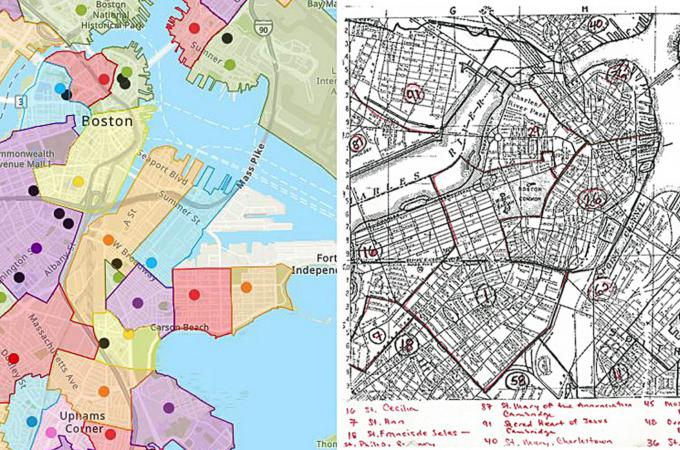Archive offers new Parish Boundary Map Tool
The Archive Department is pleased to announce a new Parish Boundary Map Tool.
It is a digital map of the Archdiocese of Boston, which features parish churches and boundaries. Each territorial parish church is represented by a dot whose corresponding boundary is shaded in a matching color, while the personal, or national, parish churches are represented by black dots. It is a depiction of the archdiocese ca. 1955, when a concerted effort was made to compile parish boundary information, and a reflection of the archdiocese at its approximate height in terms of number of parishes.
The tool allows users to enter an address that will then be plotted on the map, indicating which parish a family at that address would have most likely attended, and other nearby churches. Since records are maintained at the parish level, we hope it will help users determine which parish they or their families attended and therefore help locate sacramental and other records.
This is particularly useful for genealogy, as addresses found in census and vital records can now be used to determine where one might find complementary Catholic records, and we recommend using this tool in conjunction with our free-to-browse sacramental record collection available on AmericanAncestors.org.
The tool can be accessed via the "Researcher Resources" page (www.bostoncatholic.org/researcher-resources) on the archive website and is also linked in the database descriptions of our two digital sacramental record collections on AmericanAncestors.org.
More about parishes
When we think of a Catholic parish, the image that comes to mind is that of a church building. However, a Catholic parish is a community, defined by its geographical area or, in some cases, by the common language and cultural practices of its people.
Canon 518 states, "As a general rule, a parish is to be territorial, that is, one which includes all the Christian faithful of a certain territory. When it is expedient, however, personal parishes are to be established determined by reason of the rite, language, or nationality of the Christian faithful of some territory, or even for some other reason." There are, then, two broad categories of Catholic parishes: the territorial parish and the personal parish.
Territorial parishes are the most common type of Catholic parish and assigned a specific geographical area. In large, densely populated cities, this area may be relatively small, encompassing only a few city blocks. In more rural areas, parishes may encompass whole or multiple towns. It is the responsibility of the diocesan bishop, in consultation with the pastors of nearby parishes, to set parish boundaries. These boundaries may change over time, as new parishes are established, parishes close, or demographics change.
From the perspective of a pastor, parish boundaries are useful administrative tools, outlining the scope and limit of his responsibility. Unless they attend a personal parish (see below), Catholics living within his parish boundaries are his responsibility -- members of his parish whether they know it or not, and, crucially, whether they attend his church or not.
Through the first half of the 20th century, the vast majority of American Catholics attended their assigned territorial parishes. At a time when the Tridentine Mass provided a relatively uniform liturgical experience, travel by car was limited, and the demographics of neighborhoods were largely stable, most Catholics found it unnecessary -- even unthinkable -- to go elsewhere. Those who did want to attend or make sacraments in a different parish had to request permission in writing from their bishop. Often, this permission proved difficult to obtain.
After World War II, the territorial parish began to lose its centrality to the Catholic Church in America. The forces of economic prosperity, suburbanization, and increased mobility combined to sever the traditional connection between a parish's geographical boundaries and its people. In the 1960s, the Second Vatican Council catalyzed these changes further, by allowing for a diversity of liturgical practices. Catholics began to choose to attend churches with the styles of music, seating arrangements, or ornamentation that they liked best. The council had emphasized that laypeople should be full participants in rather than spectators of the Mass. An unintended consequence of this emphasis was that laypeople also began to express their preferences over what that participation should look like. Although Catholics still had to request permission from their bishops to attend a different parish other than their geographical parish, that permission became more rarely sought and more often granted.
The second type of Catholic parish is the personal parish, sometimes called a "national parish" or an "ethnic parish." Rather than serve a specific geographical area, the personal parish serves a specific subset of the population, bound together by rite, language, nationality, or other commonality. In America, personal parishes are most commonly established for immigrant communities, so that they might worship together in their own languages and practice their own traditions.
In rare cases, such as when multiple parishes for the same community are established in one city or region, personal parishes may be given geographical boundaries. These boundaries apply only to the members of the particular community of the personal parishes, rather than to all Catholics living within the assigned territory. For example, if there are two French churches in one city, boundaries are established to determine which of the two parishes the French Catholics of a particular area should attend.
THOMAS LESTER IS THE ARCHIVIST OF THE ARCHDIOCESE OF BOSTON. VIOLET HURST IS AN ARCHIVIST FOR THE ARCHDIOCESE OF BOSTON.
- Father Thomas Ryan, CSP, directs the Paulist North American Office for Ecumenical and Interfaith Relations in Boston.



















